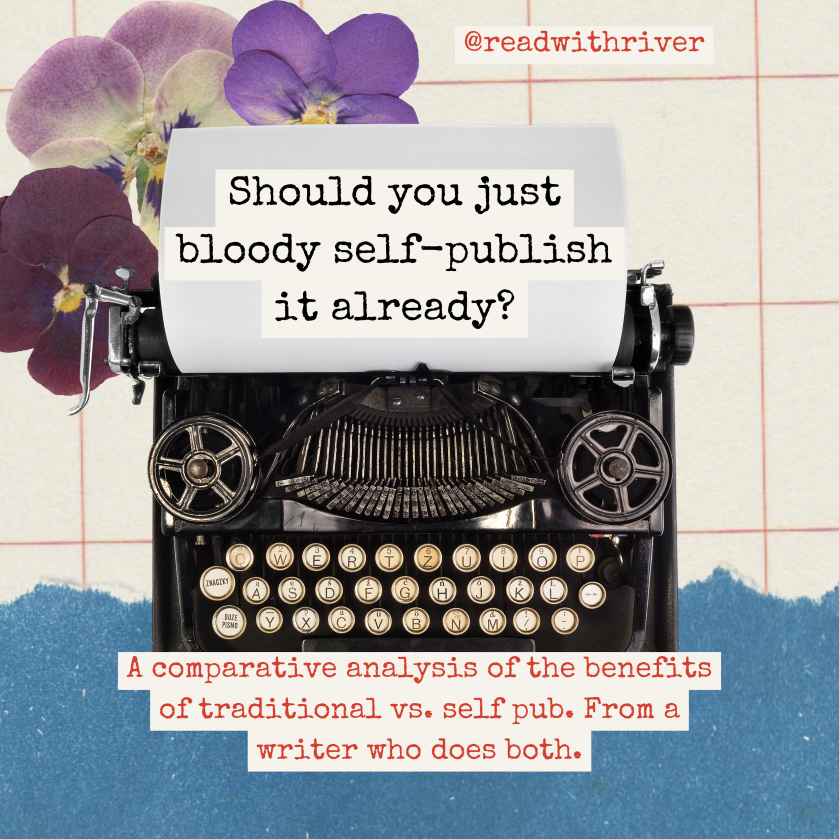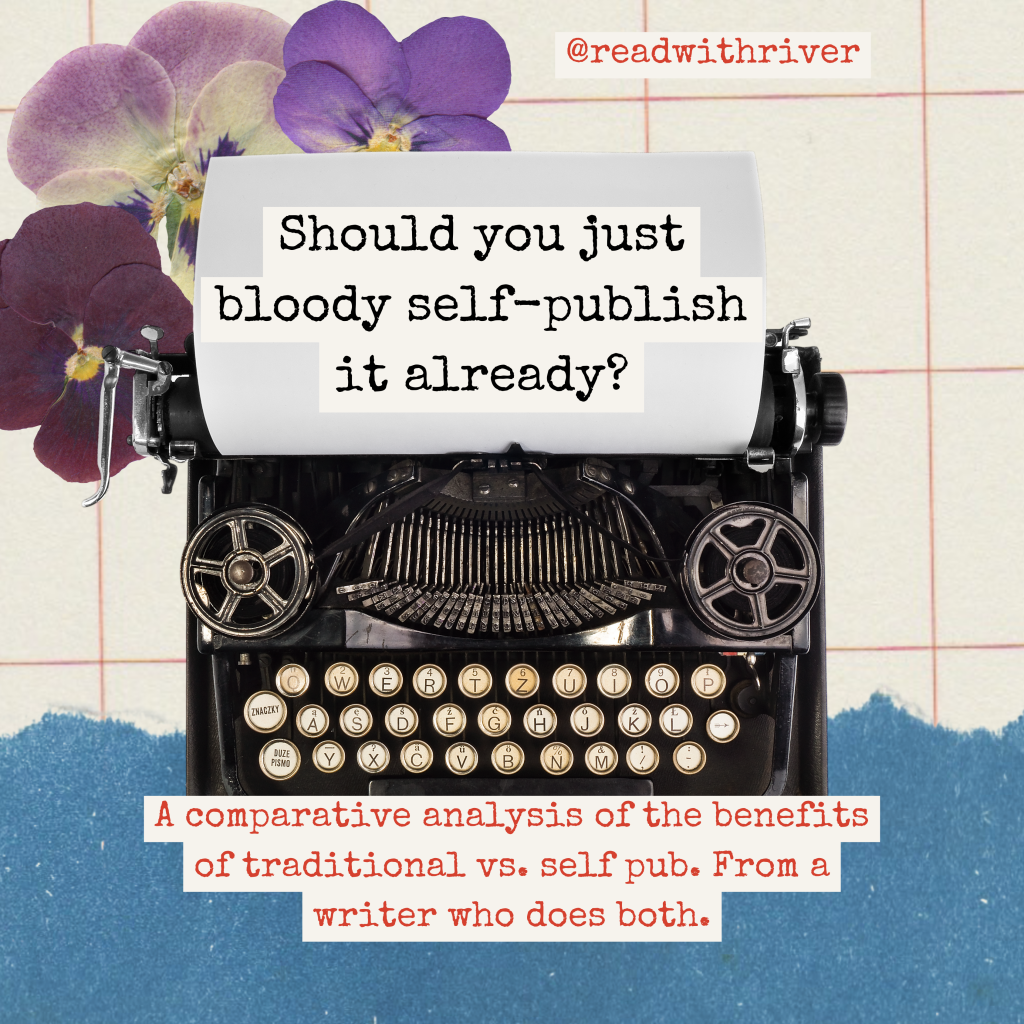
How does a person get their book published? Well there are a lot of different options actually, and though at times that may seem overwhelming to a writer just trying to find their way, we are lucky to be writing in this world with all of the various avenues available to us. If you’re feeling uncertain of what is right for you, and where to begin, let me break it down for you.
First of all you have two main choices, and then within that there are a lot of variables: Traditional vs. Self-Publishing.
Traditional Publishing
Traditional publishing is when a publishing house acquires a manuscript from a writer in exchange for an advance (money). The publishing house then takes that manuscript and it goes through several stages of development at the publisher’s expense, to bring it to it’s final form on the shelves in a bookstore. There are dedicated departments for each element of creating, selling, and publicizing the book: editing, design, layout, binding & printing, shipping, sales, marketing, and publicity. After the book is published, the author begins to receive royalty payments on book sales after the number of sales exceeds the advance that the author was paid upfront.
Variations in Traditional Publishing Houses
There is a huge variety within the realm of traditional publishing. Some publishing houses are enormous, and buy out smaller ones (such as Penguin Random house, Simon Schuster and, Hachette.) These houses publish and distribute thousands/millions of books each year world wide. Meanwhile other publishing houses (indie publishers) are tiny, a handful of people each doing three departments each and publishing only a few new titles each year with potentially very small print runs of a few thousand or less. The quality and vibe of each of these houses is entirely different and there are relative benefits to working with a big house vs. an indie.
Big House Benefits:
-Bigger budgets for every department mean a lot more is possible
-More money for marketing
-Access to more opportunities for your book to be carried in different stores worldwide
Indie House Benefits
-Each person working on your book is passionate and committed to its success.
-More likely to take risks in terms of edgy content, new and up and coming illustrators, etc.
-Authors have more contact with their publisher, and potentially more say in decisions made about their book.
Independent publishers and self-sublishing are NOT the same thing. Although often people might label a self-published book as coming from an independent publishe when it is not. There are key differences between an independent small publisher and self-publishing.
What is Self-Publishing?
Self-Publishing is when a writer produces their own book and personally sells it. There is no submission process, no gatekeepers deciding whether or not a manuscript becomes a book. There are no outside factors in the decision to publish, it is undertaken at the author’s expense. There are different ways to self-publish, some are more expensive and time consuming than others.
The easiest and fastest way to self-publish a book is using Amazon KDP. All you have to do is upload a pdf of your manuscript and within seventy two hours it will be available for purchase in much of the world via Amazon. The most difficult part of this process is getting the formatting of your pdf correct, that can be a bit finicky and annoying. Allowing for tech difficulties in pdf formatting it will still only take you a couple of days to complete. Amazon then gives you a percentage of those sales directly deposited to your bank account, and you can control the price of the book. Amazon will take most of the profit.
Some people go to great lengths and invest huge amounts of money to take their manuscript and have it produced more like a traditionally published book than the Amazon route, this is still at their own expense. I have heard of some people doing Kickstarters to help cover the costs of self-publishing like this. There are services that offer to do much of this for a price of a few thousand dollars, but some people go all out and pay for high end editing services, layout and design, the best printing and binding, marketing assistance. This can run a writer up $15,000 or more.
Which option is right for you?
Well that really depends on you and what your needs and goals are. It also kind of depends on your personality, entering into the traditional publishing world can be quite grueling and cruel and it’s not for everybody.
Let’s compare based on a case study of my own books.
The Books in Question
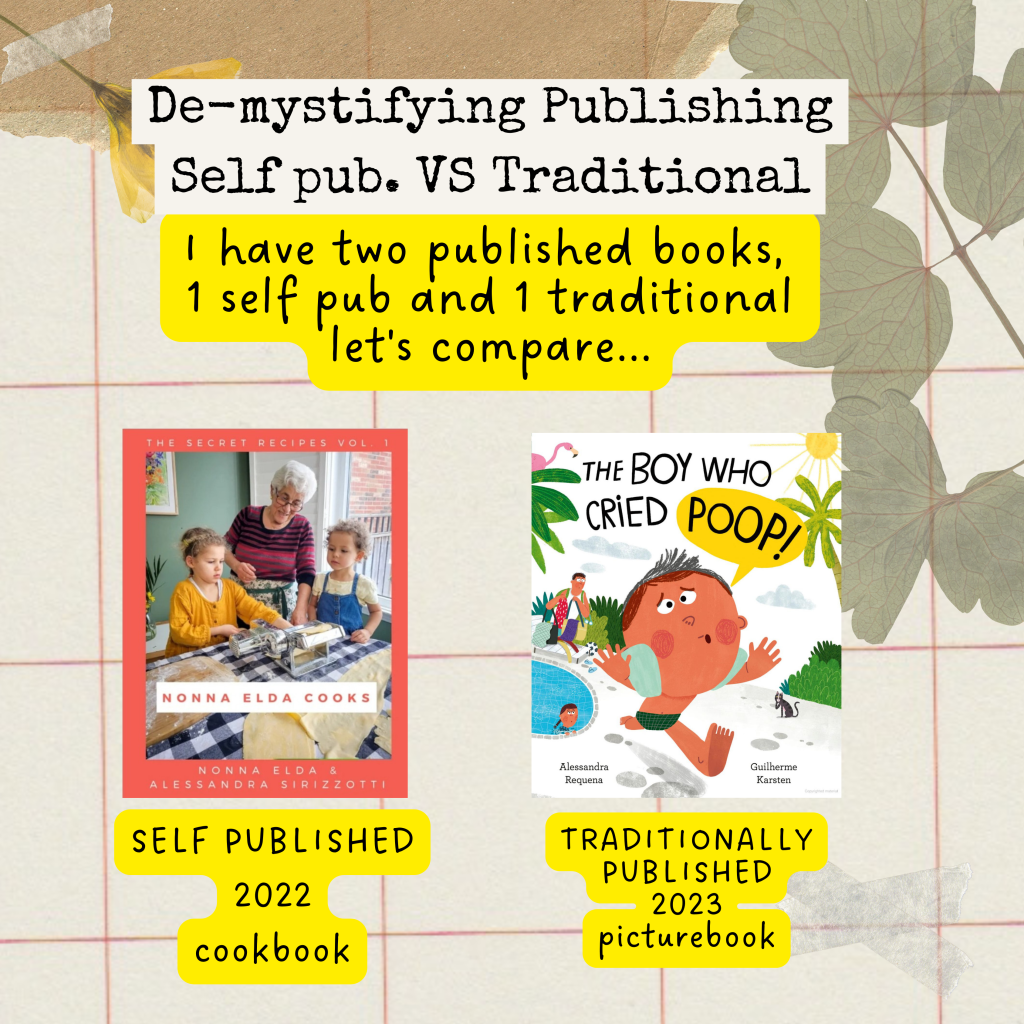
Self-Pub:
I have three self-published cookbooks available on Amazon in print form (they are also now available as pdf downloads on www.nonnaeldacooks.com for anyone who doesn’t wanna pay Jeffy). I made these cookbooks from my grandmother’s recipes, we run a social media channel where we make her recipes @nonna.elda.cooks with almost 700K followers across all of our platforms (IG/TT/FB). I made each of the three cookbooks using Canva pro, each book took me a few weeks to put together, I made them alone, no outside editors or layout designers were involved. The artistic quality is mid at best, I made it on Canva from cell phone photos what the heck do you expect? However it does the job of giving you the absolutely phenomenal secret family recipes you can’t get anywhere else and I have a large built in audience to sell it to. Today we will look at the first cookbook which was published in August of 2022 for our comparison.
Traditional Pub:
I have one traditionally published picturebook currently out “The Boy Who Cried Poop!” (about the time my brother took a dump in a pool in 1992 which I think is hilarious, he thinks it’s less hilarious). It’s out with the publisher Frances Lincoln, an imprint of a larger publisher called Quarto. The picturebook was released in June of 2023, and it is currently available in 7 languages worldwide. We will be using this book for comparison, and the numbers statements included will be from the first six months (because the publisher only issues us statements once every six months, which is annoying.)
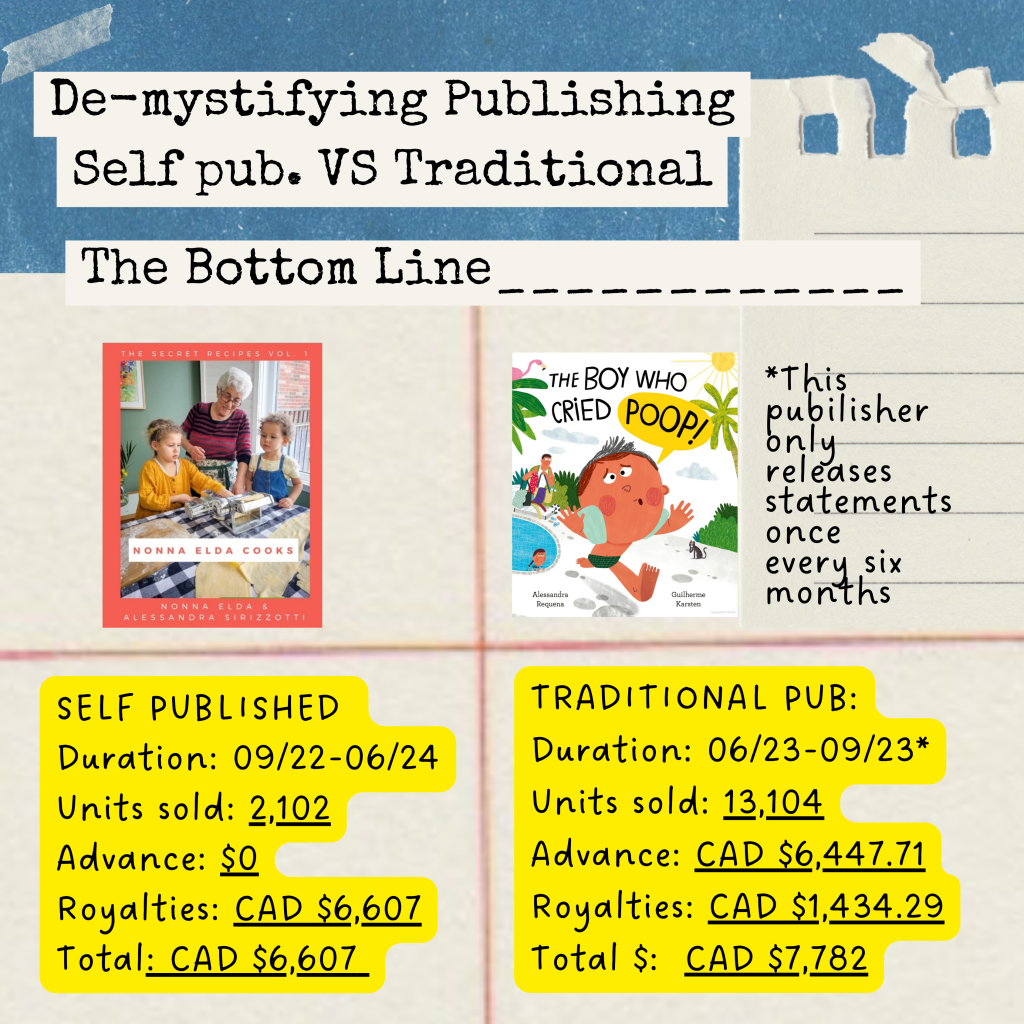
Let’s look at the bottom line numbers here of how the two books compared on the big items.
Units Sold, Selfie 2,102 vs. Trad 13,104.
Traditional publishing destroyed this competition which was actually kind of a surprise to me because we have such an enormous following backing us up on Nonna Elda Cooks. A lot of influencers who approach me asking for advice because they want to do self-publishing often say “well selling the book won’t be a problem because I have X number of followers” the reality is only a small fraction of your following will actually click through and purchase something like a book 90% are only there for free content. (It’s much easier to get a follower to switch brands, especially for a product that they feel they need than it is to get them to purchase a recipe book especially when they can view your recipes for free.) So if you have a following behind you and think you can rely on them to purchase, you might need to readjust your expectations. Of the over 650,000 followers we have on Instagram, Tiktok, and Facebook, only 2,102 people went and purchased the book even with constant reminders. We also have a tip jar available on our blog where we share free recipe downloads with over 50,000 visitors in the last six months, not a single person has ever tipped us when taking one of the free downloads. People will absolutely not give you money on the internet unless it’s completely and totally necessary.
Traditional publishing was definitely more successful in getting a much larger volume of books out. “The Boy Who Cried Poop!” book was sold into bookstores worldwide, and translated into seven languages. Despite being available for a much shorter period than the cookbook, 6 months vs. the 1.5 years, it was purchased by way more people.
Why is traditional publishing better at selling a larger volume of books?
It comes down to resources and connections and the reason why people are purchasing the book. The self-published book is only available in one place, admittedly it’s Amazon so that means people can access it all over the world but that is still only one language and one bookseller. The people purchasing it are making that choice because they know who we are and want our recipes. They’re not buying it for its artistic integrity. People buy the picturebook because it’s beautiful and they just think their kid will like it so I don’t need to create a connection with every single buyer of the picturebook.
The traditionally published book is available in many places where books are sold, as well as libraries. The publishing house has an entire network of connections to big bookstores as well as other kinds of stores that sell a selection of books such as Walmart, Costco or pharmacies. The sales team are dedicated to going out and convincing the buyers for all of these different places to stock their books. This has so many possibilities and so much potential for reaching people in all kinds of places.
The traditional publishing house also sells the rights to the books worldwide to other publishers. For example my picturebook is published by Quarto (Frances Lincoln mprint) in Britain and the United States but in Canada its distribution rights have been sold to Manda group, in Australia those rights have been sold to Thames and Hudson. Translation rights have been sold to various publishers around the world and each of those publishers have the book translated (Korean, Danish, French, several different kinds of Spanish) and they sell the books in those countries. Those publishers each have their own connections and sales teams to get the books into stores in those countries. Multiple print runs have been ordered and sold in Korea for example. This is just not a possibility for a self-published book. This is the reason that traditional publishing will always have the ability to sell bigger numbers worldwide.
Then of course actual money is spent on the marketing of these books, so that people see the book in a variety of contexts, it’s not just being shown to my followers on social media. There are so many different reasons that the book is more readily available, and more heavily marketed with traditional publishing.
MONEY
Per book sold self-publishing put more money in my pocket. My cookbooks brought in $3.14 CAD per book direct to my account, versus the traditional publishing where between my advance and royalties each book sold brought me $0.36 CAD.
You might be yelling “36 CENTS? WHAT? WHY EVEN ASK US TO BUY IT?” To which I say, “Yeah I know! That seems really little doesn’t it!” When you consider how many people work on the book and the costs associated with it, it makes a lot of sense. So if the book is retailing for CAD $27 and they are giving me CAD $0.36 cents, the other CAD$26 bucks have to pay not just the illustrator but all the other people working at the publishing house, the paper printing and binding costs of making the book, the rent fees of housing the stock of books in warehouses, the delivery truck drivers who take it to the store, the cost of any returns of said book. A certain amount of the purchase of each book also goes towards marketing that title in future. Publishers do not turn a huge profit, the margins on selling books in a publishing house is around or less than 10%, and any profits made are being put into making offers on new book acquisitions. The CAD$27 has to do a lot of heavy lifting to support a whole industry of people who barely make a living wage and that’s why authors make almost nothing per book. It’s also why every book sale is essential to keeping the publishing house going, and also to ensuring that an author gets future book deals.
On the other hand when you’re selling with Amazon you make a higher profit per book but the rest of that cost is getting eaten up by Amazon. So each book was listed at CAD$15, I made CAD$3. Something like CAD$4 of it went to paper printing and binding costs and the remainder went to Jeff Bezos. So Jeff makes like $9 on my work, and I make $3. I have to say I don’t love that. I’d rather know my work is helping to support my editor and his wife, and the layout designer and their girlfriend, and the marketing dude and his dog, my agent who is an angel on earth and really should have all the dresses she wants off of Son de Flor. I hope I sell a million books, and my agent gets some really ridiculously extravagant dresses one day.
At the end of the day I still made more money traditionally publishing than self-publishing even though the take home per book is much higher with Amazon KDP because of the volume of the sales and distribution that a traditional publisher can support.
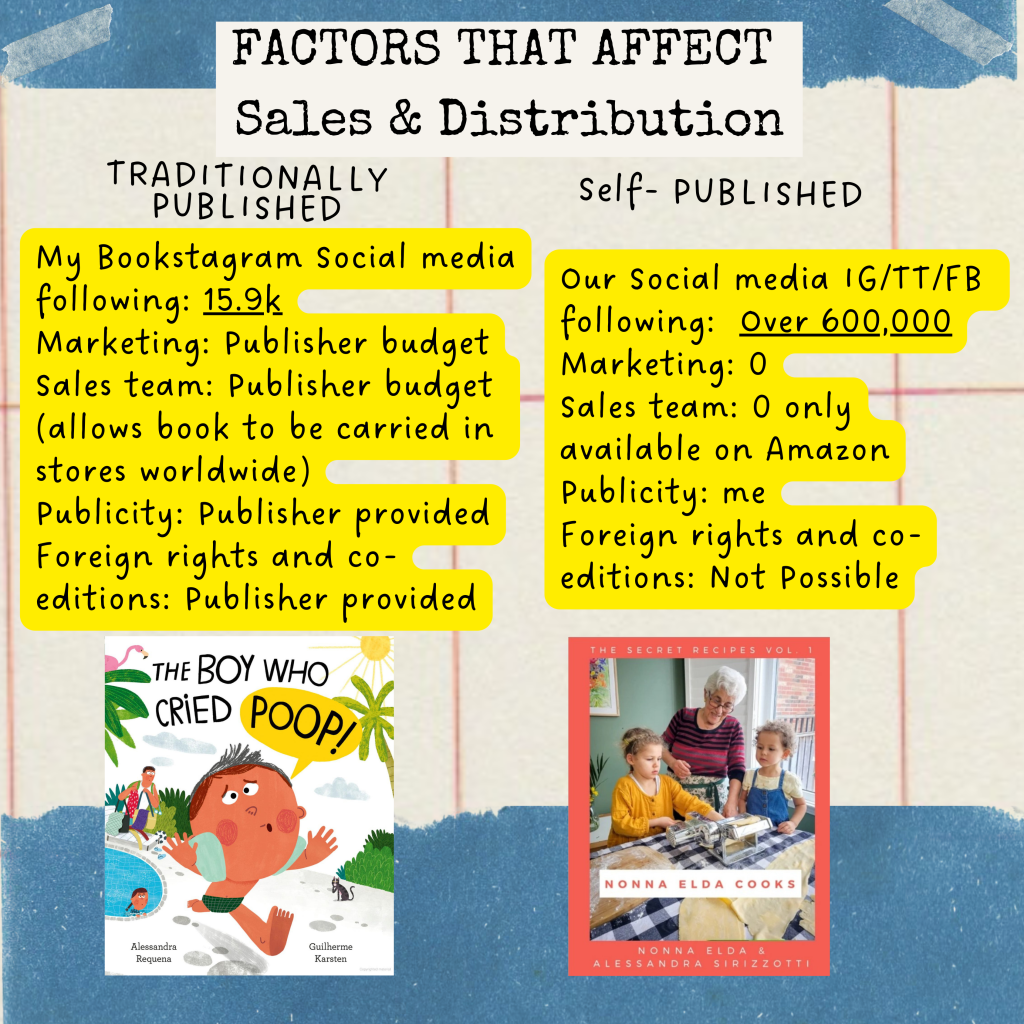
Time and Labour
Self-Publishing
I had to do everything for the publication of the cookbooks myself, writing, editing, photography, photo edits, lay out, design, setting up the Amazon landing site, doing all the copy and SEO. Then driving traffic to the book and getting people to purchase it was again all me (and my grandmother who appears in our videos.) When you self-publish you need to find your audience and convince them to purchase your book, so that meant months of creating and putting out content on social media. Every sale made was from our own publicity we had zero dollars in marketing.
So in one way, the time it took to make the actual cookbook and push it out into the world was a lot less. It was about three weeks for me to put the actual book together and hit the publish button on KDP. But creating the audience base, making the recipes and photographing them as content, everything took months. Any ongoing sales we continue to have is because of basically a full time job creating content driving traffic. There is a lot of time and labour that goes into not just making a self-published book and then having it available for purchase, but in getting people to buy it.
Traditional Publishing
So this is a picturebook and the actual writing of the story didn’t take that long, it was maybe a two week period of thinking and editing it with my agent. My agent then took the story and did all of the work of submitting it to editors (he makes a 12% cut of all my advances and royalties, which is actually a little less than standard 15%.) I think this took a few months.
Once we had an interested publisher, between them expressing interest and us signing the book deal it was another three months or so. Then after that it was a full year and a half where the publisher was going through the process of turning it into a book. I did a few light edits with my editor Pete after the illustrator had been brought on board but that was it until the book was released.
After the release and during the lead up I did a little bit of promotion, I have a bookstagram account @readwithriver where I did some posts there. The majority of my marketing and publicity was arranged and paid for by the publisher however.
Over all I would say the traditional book was less work and labour on my part after the initial writing was done. However the time spent waiting was enormous.
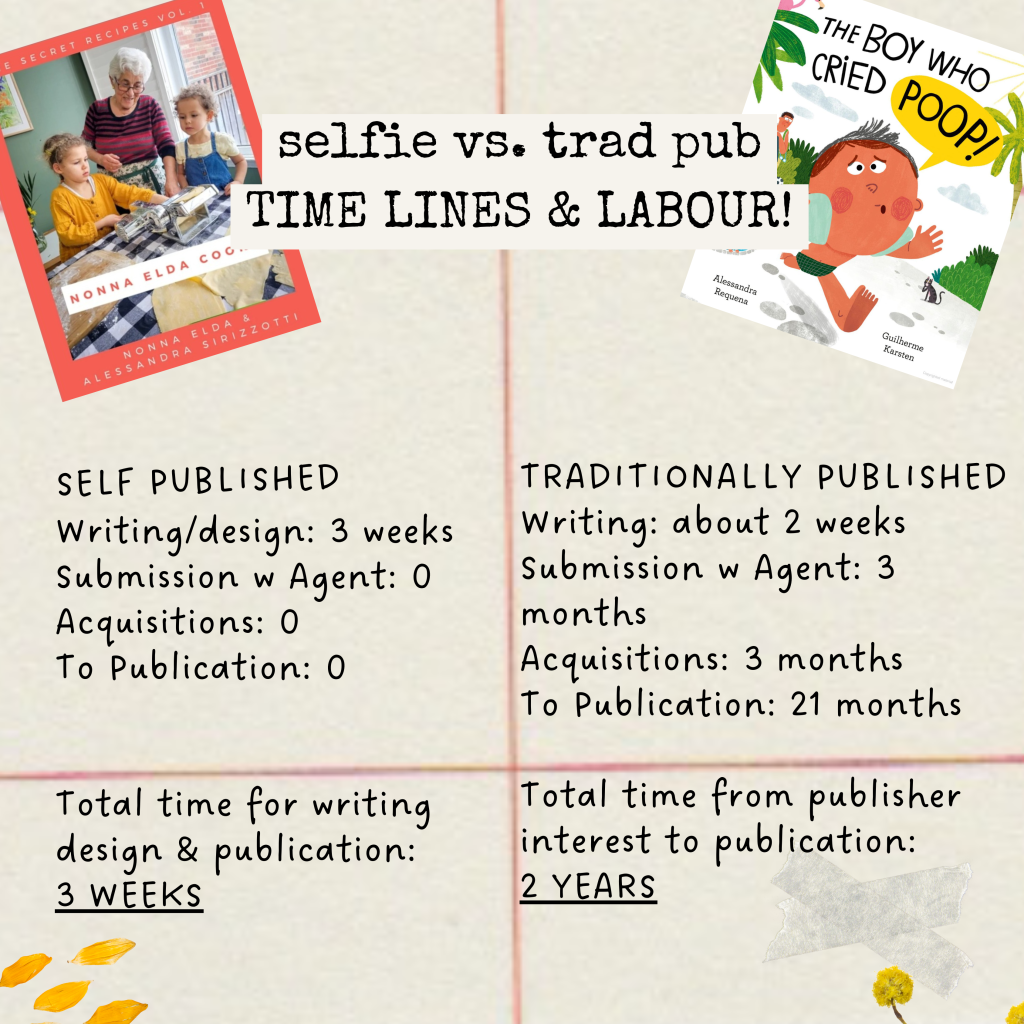
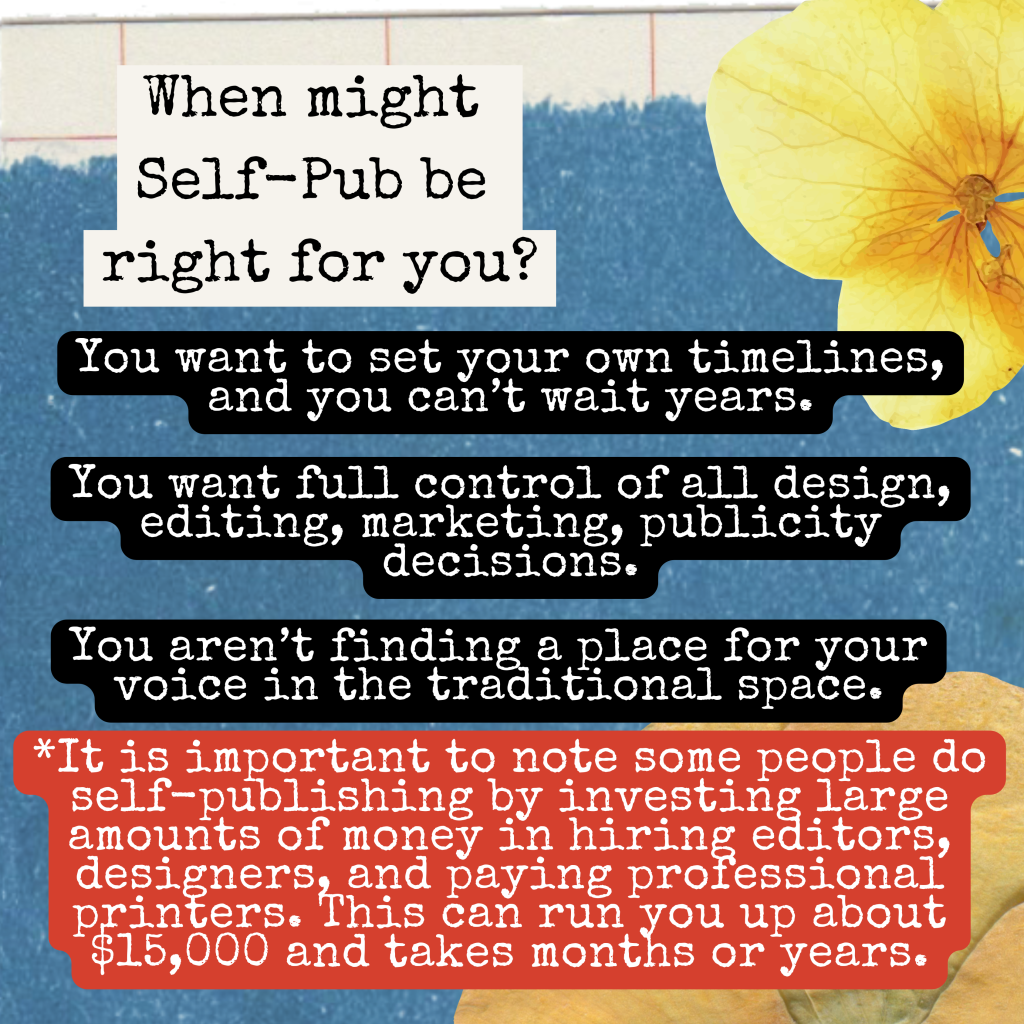
From my own experiences I have to say I think self-publishing has a lot of advantages and based on your needs, goals, and particular situation might be the right choice. Try writing down what your goals are and why, to help you figure out if it’s in line with what you can get from self-publishing.
I would and will use self-publishing again. In my particular circumstance with this book I needed to have a way to monetize my social media channels to pay for the time and items needed to run the channel. I just did not have the time to shop the cookbook around extensively. We actually did pitch the cookbook to several publishers, and despite the social media following we were rejected. I didn’t have the time to approach it from another angle, and then go through the years of waiting to release it. So for us, self-publishing the cookbooks just made sense.
Additionally the cookbooks didn’t need to be art in the same way as a picturebook has to be art. Yes most traditionally published expensive cookbooks are coffee table books that double as art, but that’s not what we needed to make. The cookbooks we provide are meant to provide a written recipe and directions for our followers to use, who need to see the words written out for the dishes we make in our videos. We are capable of providing that in a simple pdf with our photos without all the bells and whistles.
For us it was a no brainer self-publishing was the only real option for us to get what we needed for these cookbooks. I think it was the right choice, and I would use this avenue again in future for a purpose like this. It’s a great tool, with no overhead costs.
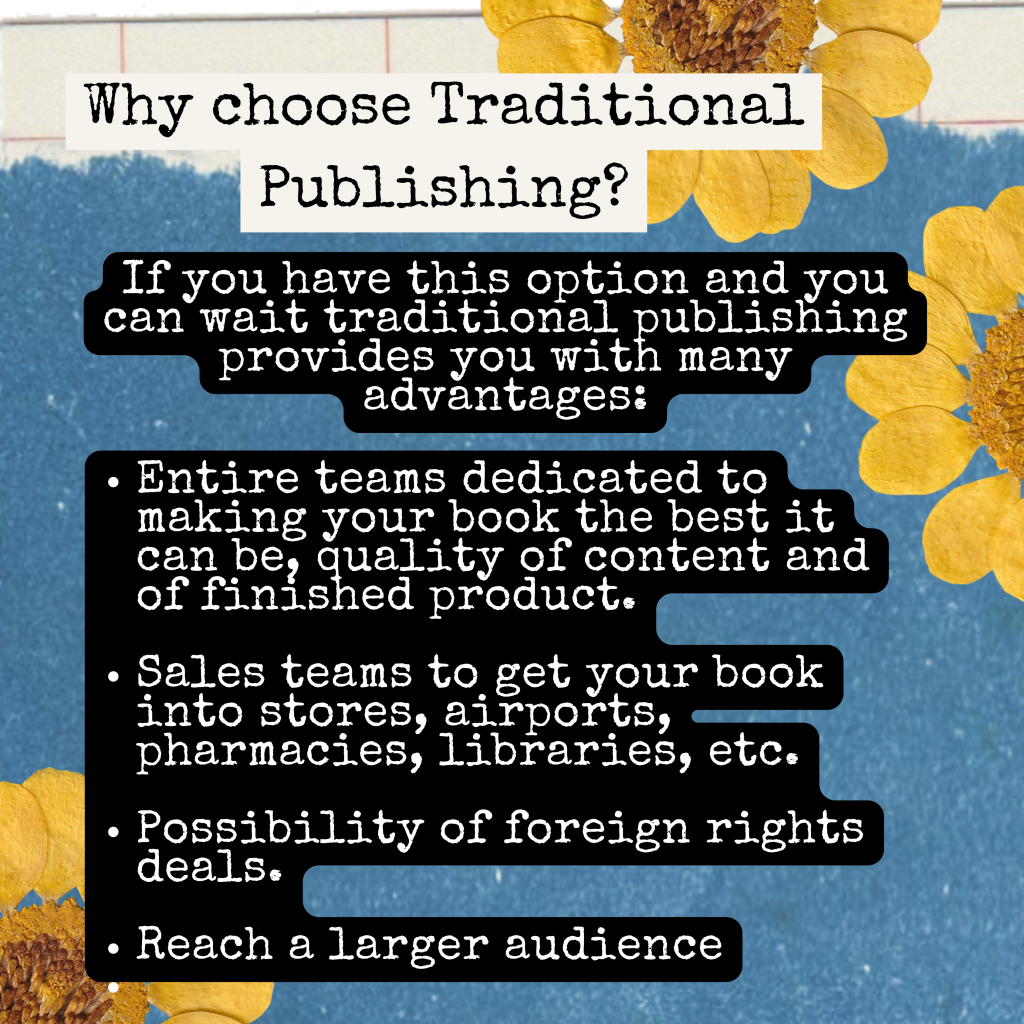
Traditional publishing is full of gatekeepers, and if you don’t have personal connections with those gatekeepers it’s a huge hurdle. Getting in is almost impossible, and even if you spend years submitting to publishers and agents you just might not get through. There are thousands of submissions every year to each publisher, only a handful of manuscripts are chosen from each to be published.
There are lots of reasons for why this avenue might be closed to you so simplifying it down to whether or not you can choose to traditionally publish is reductive. However if we are simply comparing the relative benefits, the fact is that traditional publishing offers writers who have the time and resiliency to rejection to wait for an offer more of a real career long term.
If you are sitting here wondering where to go and you haven’t begun the journey of submitting your work to publishers and agents yet, you need to ask yourself what your goals are and how much you’re willing to undergo for it.
If you want to set yourself on the traditional publishing track you need to ask yourself if you are going to be ok with the following three inevitable realities:
First, there will be a lot of rejection. It will be constant and you’re going to be expected to take it with grace and say “thank you may I have another.” There’s a certain amount of masochism inherent in writing for the traditional market, sorry.
Second, it’s going to take for bloody ever. It’s going to be years. If you’ve ever built an addition on your home or done some construction project that took over your life, it’s like that. Finding out information about what’s happening? Meeting timeline goals, nope. Forget about it. Get ready to hurry up and wait.
Third, traditionally published books are a product of teamwork. This is a beautiful thing because each member of the team specializes in whatever element they’re bringing to your book. However this will mean accepting criticism, and compromising on the book you’ve written. Your final book is probably not going to look or be what you imagined initially, it’s not just your baby. You’re co-parenting that baby with a whole team now. Are you okay with that? It’s okay to say “no, I’m not” and make decisions knowing that about yourself. Personally? I’m a complete sell out, seriously the price isn’t even that high. I will add aliens, I will delete entire characters at the drop of a hat if it means I take home that advance. Artistic integrity be damned I may be an artist but I do not have any desire to starve for it.
If you’re at the beginning stages here and you’re still nodding your head saying yes I want this, I want to be a traditional author, I accept all of this but you’re not sure where to start? I have three avenues for you to consider, and some information available to you here on this blog to begin.
Next Steps for Pursuing Traditional Publishing
- Peer Review/Edits/Beta Readers
First have you taken your manuscript to be peer reviewed or edited professionally? You can do this in different ways, there are organizations like SCBWI that have writing groups, or local organizations like your community library or community college. You can also enlist the help of a professional editor (I personally offer manuscript review and feedback for picturebook texts.)
2. Querying a Literary Agent
Second, approaching an agent. Do you want an agent? Not every author has an agent and you don’t strictly require one to become an author. I personally have one and I can’t live without them. You can see my blog article on literary agents for more information one what they do, and how to approach them.
3. Submissions
Third, open submissions to a publisher. Do you want to skip getting an agent, or are being continually rejected by agents and would like to go straight to a publisher? Not all publishers accept unsolicited submissions. You can check out my blog post on open submissions (that means they consider manuscripts from un-agented writers). There’s a spreadsheet with a list of traditional publishers who accept open submissions for your convenience that includes how and where to submit to them.
Hope that helps!
Subscribe and follow @readwithriver for more ‘De-mystifying Publishing’
If you found this helpful you can support my work here by buying my book “The Boy Who Cried Poop!” Or requesting it at your local library. If you already have a copy (thank you) leaving a review on Goodreads or Amazon would be such a fantastic help. I appreciate you all!
